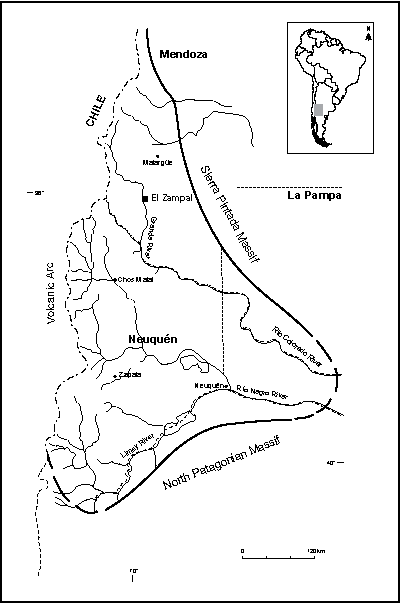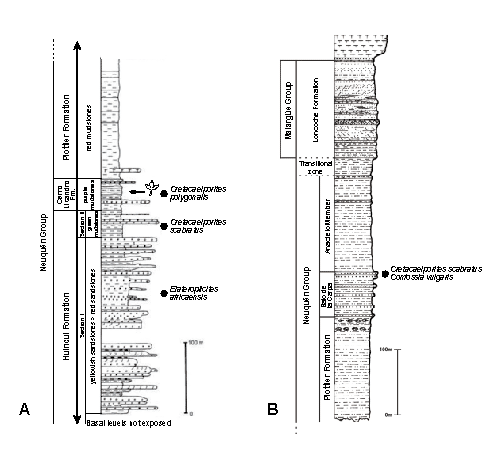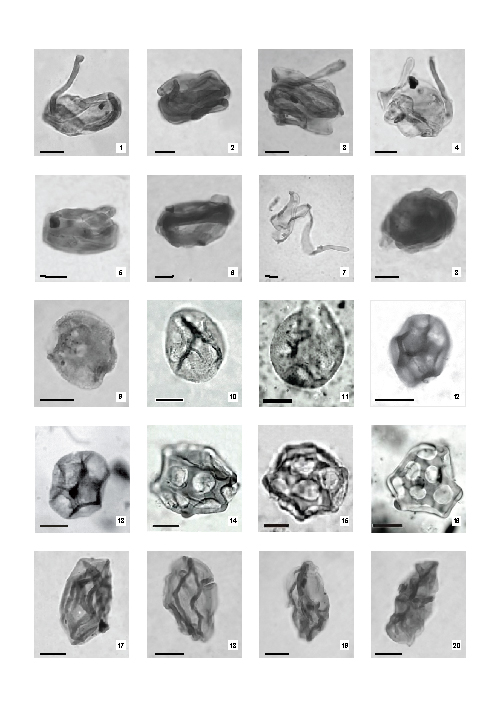◄ Carnets Geol. 13 (L05) ►
Contents
[Introduction] [Paleotropical representatives in Northern Patagonia] [Conclusions]
[Bibliographic references] and ... [Appendix]
Laboratorio de Bioestratigrafía, UNPSJB, Ciudad Universitaria, 9000, Comodoro
Rivadavia, Chubut (Argentina)
Manuscript online since August 2, 2013
[Scientific and
language editor: Robert W. ; copy editor: Bruno ]
This paper discusses the presence of elater-bearing pollen grains and other characteristic paleotropical palynomorphs in the mid to Late Cretaceous Neuquén Group at the El Zampal locality, south of Mendoza Province, Argentina.
The elaterates characterize the equatorial paleofloristic province in the Albian-Cenomanian. The species Elateroplicites africaensis is present in the pollen assemblage recovered from the lower section of the Huincul Formation, a basal unit of the studied Neuquén Group. It represents the first record of elater-bearing pollen grains in Argentina and marks their southernmost extension. Other conspicuous paleotropical elements recorded in different lithostratigraphic units of the Neuquén Group include gymnospermous polyplicate pollen grains and angiosperm pollen, including two species of the periporate pollen genus Cretacaeiporites and the triporate pollen species Confossia vulgaris. The paleobiogeographic and biostratigraphic significance of the paleotropical sporomorph record in the Cretaceous palynofloras of the Neuquén Group at El Zampal is herein discussed.
Paleotropical palynomorphs; mid and Late Cretaceous; Neuquén Group; Patagonia; Argentina.
P. (2013).- Paleotropical pollen grains from the Neuquén Group, Patagonia, Argentina.- Carnets de Géologie [Notebooks on Geology], Brest, Letter 2013/05 (CG2013_L05), p. 273-279.
Grains de pollen paléo-tropicaux dans le groupe de Neuquén, Patagonie, Argentine.- Cette note discute la présence de grains de pollen à élatères et d'autres palynomorphes paléo-tropicaux caractéristiques dans le Groupe de Neuquén d'âge Crétacé moyen à supérieur de la localité d'El Zampal au Sud de la Province de Mendoza en Argentine.
Au cours de l'intervalle Albien-Cénomanien, les élatèrates caractérisent la province paléofloristique équatoriale. L'espèce Elateroplicites africaensis est présente dans l'association de pollen extraite de la partie inférieure de la Formation Huincul, à la base du Groupe de Neuquén. C'est la première fois que des grains de pollen à élatères sont découverts en Argentine et cela correspond aussi à leur occurrence la plus méridionale. D'autres éléments paléo-tropicaux incontestables sont présents dans différentes unités lithostratigraphiques du Groupe de Neuquén : ce sont, par exemple, des grains de pollen polyplicates de gymnospermes et des grains d'angiospermes, incluant deux espèces à grains périporés du genre Cretacaeisporites, ainsi que l'espèce Confossia vulgaris à grains triporés. La signification paléogéographique et biostratigraphique de l'association de sporomorphes crétacés paléo-tropicaux extraite du Groupe de Neuquén à El Zampal est discutée.
Palynomorphes paléo-tropicaux ; Crétacé moyen et supérieur ; Groupe de Neuquén ; Patagonie ; Argentine.
This contribution focuses on the paleotropical pollen recovered from different lithostratigraphic units of the Neuquén Group at the El Zampal section (approximately 36°32' S, 69°39' W), 115 km to the south of Malargüe, southern Mendoza Province (Fig. I ![]() ). At this locality, the purple sandstones of the Candeleros Formation and the base of the Huincul Formation are not exposed (Fig. IIA
). At this locality, the purple sandstones of the Candeleros Formation and the base of the Huincul Formation are not exposed (Fig. IIA ![]() ). The Neuquén Group includes terrestrial post-orogenic deposits related to the main Miranic Orogeny (also known in the literature as the Patagonidic Orogeny) ( & ,
1969; , 2010).
). The Neuquén Group includes terrestrial post-orogenic deposits related to the main Miranic Orogeny (also known in the literature as the Patagonidic Orogeny) ( & ,
1969; , 2010).

Click on thumbnail to enlarge the image
Figure I: Location map of the El Zampal section in the Neuquén Basin.
Rich remains of dinosaurs and other reptiles have been recovered from various levels of the Neuquén Group (see compilations by et al., 2004). Taking into account the micropaleontological record, calcareous microfossil assemblages including charophytes and ostracods have contributed to the chronology of these continental beds (, 2000, 2006, 2010).
Previous palynological studies of the Neuquén Group have yielded angiosperm pollen assemblages comprised of diversified pollen types. These include the Fraxinoipollenites fragilis assemblage
(?Albian-Cenomanian) in the upper section of the Huincul Formation, the Cretacaeiporites polygonalis level in the Cerro Lisandro Formation (Cenomanian) and the Confossia vulgaris-Cretacaeiporites scabratus assemblage
(Santonian-?Campanian) in the Bajo de la Carpa Formation (,
2002, 2006, 2010). Typical paleotropical constituents such as Elateroplicites africaensis, Cretacaeiporites polygonalis, Cretacaeiporites scabratus and Confossia vulgaris were recorded in different stratigraphic units of the Neuquén Group (,
2006, 2010, this contribution) (see Fig. II ![]() ).
).

Click on thumbnail to enlarge the image
Figure II: Schematic section of the Neuquén Group at El Zampal (modified from & , 1978). A: lower levels of the unit, B: upper levels of the unit.
Paleotropical pollen grains have been reported from other Cretaceous palynofloras in Argentina, which also include endemic austral taxa, suggesting a mixed character for these assemblages (, 1990; , 2002, 2006, 2010; & , 2006).
In this contribution, the paleobiogeographic, paleoecological and biostratigraphic significance of the Cretaceous tropical pollen grains in Northern Patagonia is discussed, taking into account their restricted distribution in the Equatorial Region ( et al., 1996).
1. Elater-bearing pollen grains
The elaterate group includes several taxa of enigmatic pollen grains with protuberances from the Albian-Cenomanian Elaterates province, originally restricted to northern South America and northern Africa ( & , 1981; et al., 1996). The protuberances that characterize this otherwise heterogeneous group of pollen grains, are only superficially compared to the elaters of the spores of extinct calamitaceans and of Equisetum, the unique extant genus representing the Sphenophyta.
The conspicuous tropical pollen grains, reported here, were mainly recovered from the Huincul Formation in the lower section of the unit (Fig. IIA ![]() , Section I). This section includes massive grey and yellowish brown sandstones, interbedded with mudstones, siltstones and purple sandstones. Within this interval, the dark green mudstone beds yielded well preserved palynomorphs including the elater-bearing pollen grain Elateroplicites africaensis and a single specimen identified as Galeacornea? sp. (Fig. III
, Section I). This section includes massive grey and yellowish brown sandstones, interbedded with mudstones, siltstones and purple sandstones. Within this interval, the dark green mudstone beds yielded well preserved palynomorphs including the elater-bearing pollen grain Elateroplicites africaensis and a single specimen identified as Galeacornea? sp. (Fig. III ![]() , 8). The study of additional material is necessary in order to corroborate the presence of this last mentioned taxon in Patagonia.
, 8). The study of additional material is necessary in order to corroborate the presence of this last mentioned taxon in Patagonia.

Click on thumbnail to enlarge the image
Figure III: Paleotropical grains recognized in different units of the Neuquén Group at El Zampal. In parenthesis slide numbers and coordinates in the microscope. Scale bars = 10 μm.
1.1. Botanical affinity
In spite of the fact that the elater-bearing pollen grains have been intensely studied, their botanical affinity remains a matter of discussion among specialists. The morphological characteristics of these grains are unknown from extant pollen grains and up to now in situ specimens have not been found. A probable ephedroid affinity for the elaterates has been proposed by different authors ( et al., 1999; , 2001). The elaterates are, otherwise, suggested to have been a group of extinct plants with sophisticated mechanisms of pollination, which developed and diversified in the paleotropics.
1.2. Biostratigraphic and paleoecological aspects
The elater-bearing grains have a restricted stratigraphic distribution. They appeared in the Lower Albian sediments of the low latitude region, diversified, became numerically important in the Upper Albian-Cenomanian stratigraphic interval and disappeared at the top of the Cenomanian during the rapid diversification and rise to dominance of the angiosperms ( & , 1990; et al., 1996). Elateroplicites, in particular, is restricted to the Middle Albian-Cenomanian interval ( et al., 1996). The record of elater-bearing grains supports the previously suggested ?Albian-Cenomanian age for the Huincul palynoflora at El Zampal (, 2006).
The paleotropical Elaterates Province represents warm arid or semi-arid conditions ( et al.,
1996; et al.,
2013). The presence of Elateroplicites at the latitude of Northern Patagonia suggests the southward migration of favorable conditions for the expansion of the elater-bearing grains. Its restricted stratigraphic distribution in the lower section of the Huincul Formation at El Zampal should be analyzed considering the probable fluctuating environmental conditions related to the main Miranic Orogeny. These tectonic
movements were responsible for changing the regional slope from the Pacific to the Atlantic, and consequent physiographic changes.
In this sense, it is stressed that the Fraxinoipollenites fragilis assemblage, previously recognized in the upper section of the unit (Fig. IIA ![]() , Section II), which is dominated by angiosperm pollen grains and has few Classopollis and polyplicate grains, suggests a humid climate (,
2006).
, Section II), which is dominated by angiosperm pollen grains and has few Classopollis and polyplicate grains, suggests a humid climate (,
2006).
2. Periporate pollen grains
The genus Cretacaeiporites includes Cretaceous spherical periporate pollen grains with a characteristic scabrate pore membrane.
Previous palynological studies of the Neuquén Group have highlighted the presence of this pollen type (,
2006, 2010). Cretaceiporites polygonalis was reported from the Cerro Lisandro Formation characterizing a palynological level (,
2006). Cretacaeiporites scabratus was, in turn, reported from the Santonian-?Campanian Confossia vulgaris-Cretaceiporites scabratus assemblage in the younger Bajo de la Carpa Formation, in the upper levels of the Neuquén Group (, 2010). In the present contribution, the species C. scabratus is also reported from the upper section of the Huincul Formation (Fig. IIA ![]() , Section II).
, Section II).
These records from the Neuquén Group suggest that the periporate pollen type was well diversified by the mid to Upper Cretaceous of Northern Patagonia.
2.1. Botanical affinity
(1974) suggested that the species Cretacaeiporites scabratus had an affinity with the genera Trimenia, Thalictrum and Alisma. (1975) also noted the similarity of some species of Cretacaeiporites with pollen of the family Caryophyllaceae. More recently, et al. (2011) considered the presence of Cretacaeiporites scabratus in the mid to Upper Cretaceous of Brazil and Africa, as the oldest potential record of the Trimenaceae.
2.2. Biostratigraphic interest
Cretacaeiporites scabratus is distributed in the Albian-Campanian of Brazil (see , 2010) and the Upper Albian-Santonian of northern Africa (M.S. & A.E. , 2007). Cretacacaeiporites polygonalis is a conspicuous element in paleotropical Middle Albian-Early Cenomanian assemblages of Brazil, África and Perú and decreases in abundance in the Upper Cenomanian, when the triporates are first recorded.
3. Triporate pollen grains
Confossia vulgaris is a triporate pollen grain of uncertain botanical affinity. It represents a pollen probably endemic to South America and is present in the Patagonian Austral and Neuquén basins (, 1968; , 1995; , 2010) and in different Brazilian marginal basins, where it is distributed in the Santonian-Middle Campanian stratigraphic interval ( et al., 1974; , 1989).
This angiosperm marker pollen characterizes the palynomorph assemblage Confossia vulgaris-Cretacaeiporites scabratus (Santonian-?Early
Campanian) recovered from the Bajo de la Carpa Formation in the upper levels of the Neuquén Group at El Zampal (Fig. IIB ![]() ).
).
4. Polyplicate pollen grains
Cretaceous assemblages of the Equatorial Region are characterized by the common distribution of gymnospermous pollen with straight or twisted ribs ( et al., 1996).
Although not abundant, this pollen type is well diversified in palynological assemblages at different levels of the Neuquén Group. In particular, the liver-red colored siltstones and claystones of the Cerro Lisandro Formation and the Bajo de la Carpa Formation include several species of the genera Equisetosporites, Steevesipollenites, Gnetaceaepollenites and Singhia (, 2006, 2010).
New reports of polyplicate pollen grains are herein presented for the same samples including elaterates in the lower section of the Huincul Formation. Among others, Equisetosporites cf. evidens and some specimens with irregular and sinuous twisted ridges,
included as Equisetosporites spp. are recognized (Fig. III ![]() , 17-20). Equisetosporites irregularis (,
1973) , 1980 (Syn.: Ephedripites irregularis ,
1973), represented in the Aptian-Cenomanian stratigraphic interval in northeastern Brazilian
basins and Africa, is a tropical species with twisted ribs and great morphological variability. The Patagonian specimens have thinner and more irregular ridges.
, 17-20). Equisetosporites irregularis (,
1973) , 1980 (Syn.: Ephedripites irregularis ,
1973), represented in the Aptian-Cenomanian stratigraphic interval in northeastern Brazilian
basins and Africa, is a tropical species with twisted ribs and great morphological variability. The Patagonian specimens have thinner and more irregular ridges.
Distinctive paleotropical pollen taxa (Elateroplicites africaensis, Cretacaeiporites spp., Confossia vulgaris, polyplicate pollen grains) have been identified in the Neuquén Group at El Zampal, south of Mendoza Province.
The occurrence of these conspicuous paleotropical pollen grains in mid to Late Cretaceous Patagonian palynofloras suggests the southward migration of warm climatic conditions during this chronostratigraphic interval.
These pollen types represent significant palynological markers for the entirely terrestrial red beds of the Neuquén Group.
The presence of the paleotropical species Cretacaeiporites polygonalis, Cretacaeiporites scabratus and Elateroplicites africaensis in different units of this group is unique in Argentina.
The occurrence of elater-bearing pollen species in the Huincul Formation represents the southernmost known report of this pollen type. Its restricted presence in the lower section of the unit may be indicative of specific (drier?) environmental conditions.
The record of Elateroplicites africaensis in the Huincul Formation supports the ?Albian-Cenomanian age previously suggested for the Fraxinoipollenites fragilis assemblage recognized in the upper section of the unit (, 2002, 2006).
This article is dedicated to the memory of Professor Eduardo Aldo , who has permanently supported me in the development of palynological studies during the many years shared in the Laboratory of Biostratigraphy at the Universidad Nacional de la Patagonia San Juan (UNPSJB), Comodoro Rivadavia.
I would like to thank two anonymous reviewers for their careful reading and helpful comments that helped to improve the original manuscript.
V. & S. (2006).- The southernmost record of tropical pollen grains in the mid-Cretaceous of Patagonia, Argentina.- Cretaceous Research, London, vol. 27, n° 6, p. 778-787.
E. (1975).- Pollen périporé du Crétacé Supérieur du Gabon.- Revue de Micropaléontologie, Paris, vol. 17, n° 17, p. 164-170.
R., D.T. & M.E. (1999).- Morphology and ultrastructure of elater-bearing pollen from the Albian to Cenomanian of Brazil and Ecuador: implications for botanical affinity.- Review of Palaeobotany and Palynology, Amsterdam, vol. 105, n° 3-4, p. 201–235.
E.M., R. & K.R. (2011).- Early flowers and angiosperm evolution.- Cambridge University Press, 596 p.
G.F.W. (1974).- Palynology of Albian-Cenomanian strata of borehole 1-QS-1-MA, State of Maranhão, Brazil.- Pollen et Spores, Paris, vol. 15, n° 3-4, p. 514-555.
G.F.W. & A.F. (1981).- Cretaceous microfloral provinces.- Pollen et Spores, Paris, vol. 23, n° 3-4, p. 441-555.
G.F.W. & H. (1990).- Dating of the Cretaceous Une Formation, Colombia and the relationship with the Albian-Cenomanian African-South American microfloral province.- Review of Paleobotany and Palynology, Amsterdam, vol. 66, n° 3-4, p. 349-359.
G.F.W, M., L.V. & S.B. (1996).- Cretaceous palynofloral provinces: a review. In: J. & D.C. (eds.), Palynology: principles and applications.- AASP (American Association of Stratigraphic Palynologists) Foundation, Dallas, vol. 3, p. 1157-1188.
H.A. (2010).- Las principales discordancias del Mesozoico de la Cuenca Neuquina según observaciones de superficie.- Revista del Museo Argentino de Ciencias Naturales, Buenos Aires, (n.s.), vol. 11, n° 2, p. 145-184.
H.A., S., F.E. & M.E. (2004).- Cretaceous terrestrial beds from the Neuquén Basin (Argentina) and their tetrapod assemblages.- Cretaceous Research, London, vol. 25, n° 1, p. 61-87.
M.S. & A.E. (2007).- Palynology of some Cretaceous mudstones from southeast Aswan, Egypt: significance to regional stratigraphy.- Journal of African Earth Sciences, Oxford, vol. 47, p. 1–8
E.A. (2000).- Biostratigraphy and biogeography of Cretaceous Charophyta from South America.- Cretaceous Research, London, vol. 21, n° 2-3, p. 211-220.
E.A. ( 2006).- Charophyta del Cretácico tardío y el Paleoceno del centro oeste de Argentina.- Revista Brasileira de Paleontología, Porto Alegre, vol. 9, n° 1, p. 93-100.
E.S. (2010).- Upper Cretaceous Lychnothamnus, Nitella y Tolypella (Charophyta) from Zampal, Argentina.- Cretaceous Research, London, vol. 31, n° 5, p. 461-472.
E.D. (1995).- Santonian microflora of Rio Guanaco Formation (continental facies) from Rio Turbio profile, Santa Cruz Province, Argentine. In: South Atlantic Mesozoic Correlations (IGCP Project n° 381), 2, 1995.- Abstracts, Rio de Janeiro, p. 20.
M.B. (1990).- Palynostratigraphy of the Lower Cretaceous of the San Luis Basin, Argentina. Its place in the Lower Cretaceous flora provinces pattern.- Neues Jahrbuch für Geologie und Paläontologie, Abhandlungen, Stuttgart, Band 181, p. 255–266.
M.S.P. (1989).- Evolução da paleoflora no Cretáceo das margens equatorial e nordeste do Brasil.- Revista da Escola de Minas, Ouro Preto, vol. 42, n° 4, p. 17-33.
M.S.P., N. & A.S. (1974).- Palinologia dos sedimentos meso-cenozóicos do Brasil (I).- Boletim Técnico Petrobrás, Rio de Janeiro, vol. 17, n° 3, p. 177-191.
P.N. & F. (1969).- El diastrofismo eo- y mesocretácico en Argentina y Chile, con referencias a los movimientos jurásicos de la Patagonia.- Actas de las Cuartas Jornadas Geológicas Argentinas, Mendoza, tomo 2, p. 337-352.
E. (2001).- Paleoecological aspects of Afropolis/Elaterates peaks (Albian-Cenomanian pollen) in the Cretaceous of Northern Sudan and Egypt. In: D.K., & R.T. (eds.), Proceedings of the IX International Palynological Congress, Houston, Texas, U.S.A., 1996.- AASP (American Association of Stratigraphic Palynologists) Foundation, Dallas, p. 201-210.
J.B. (1968).- Palynomorphs from South America. Part 1. New Late Cretaceous palynomorphs from southern South America.- The University of Kansas Paleontological Contribution Papers, Lawrence, vol. 32, p. 1-8.
M.A. & E.A. (1978).- Microfósiles calcáreos no marinos del Cretácico Superior en el Zampal, Provincia de Mendoza. Argentina.- Ameghiniana, Buenos Aires, vol. 15, n° 1-2, p. 111-135
P. (2002).- Biostratigraphy of Cretaceous non-marine sequences in Patagonia. In: European Meeting on the Paleontology and Stratigraphy of Latin America, 3, 2002.- Expanded Abstracts, Toulouse, p. 124-127.
P. (2006).- Las primeras angiospermas en el Cretácico de la Cuenca Neuquina (centro-oeste de Argentina): aspectos geológicos relacionados.- Revista Brasileira de Paleontología, Porto Alegre, vol. 9, n° 1, p. 83-92.
P. (2010).- Asociaciones palinológicas con angiospermas en el Cretácico Superior de la Cuenca Neuquina, Argentina.- Revista Brasilera de Paleontología, Porto Alegre, vol. 13, n° 2, p. 143-158.
M.K., S.Y., H.A. & M.K. (2013).- Jurassic–Cretaceous palynomorphs, palynofacies, and petroleum potential of the Sharib-1X and Ghoroud-1X wells, north Western Desert, Egypt.- Journal of African Earth Sciences, Oxford, vol. 78, p. 51–65.
List of species illustrated or mentioned in the text
Gymnosperm pollen grains
Angiosperm pollen grains